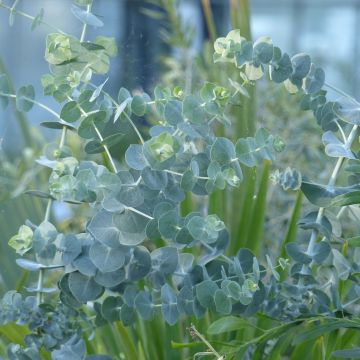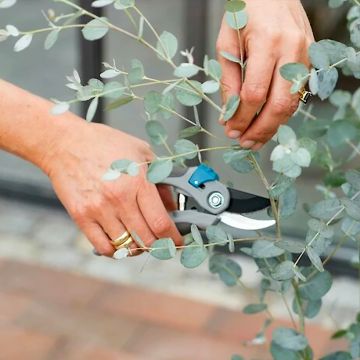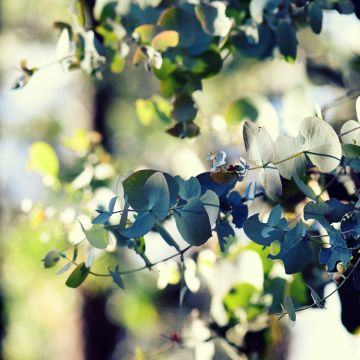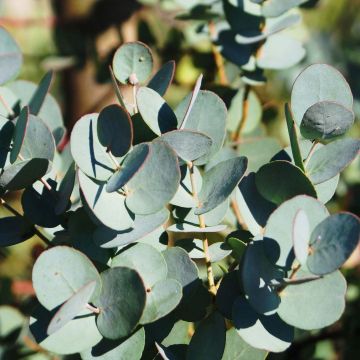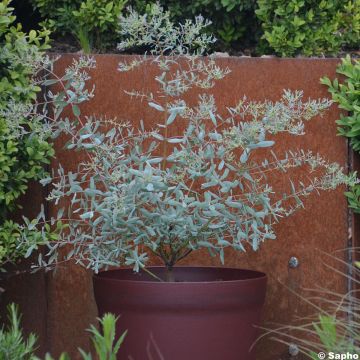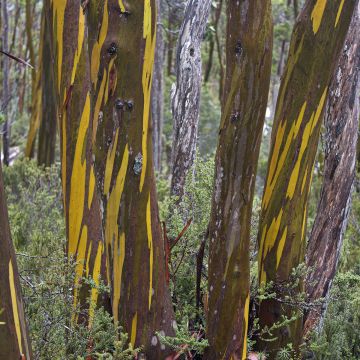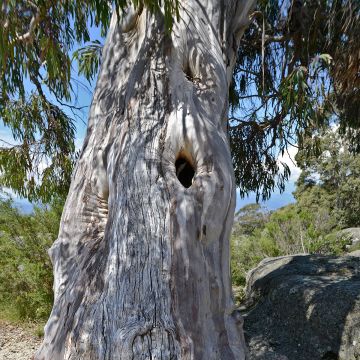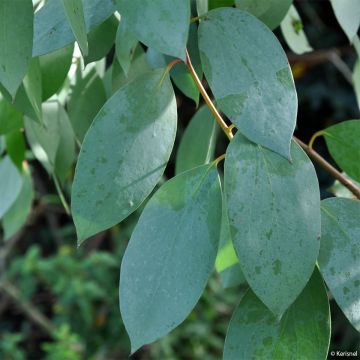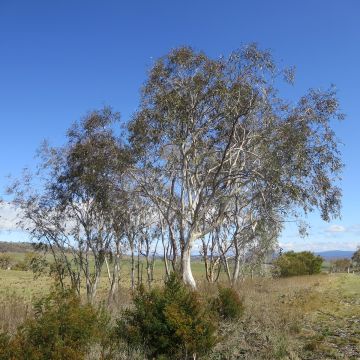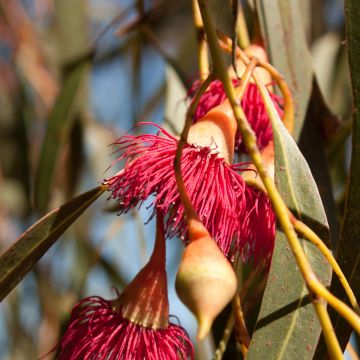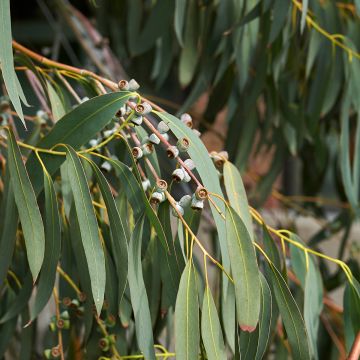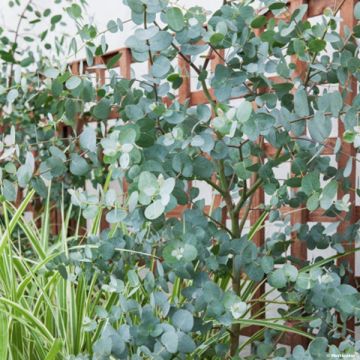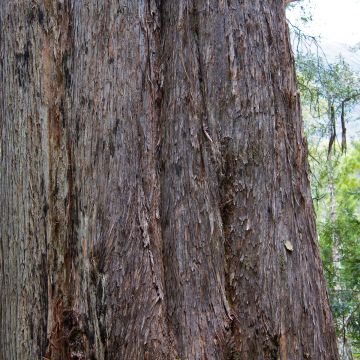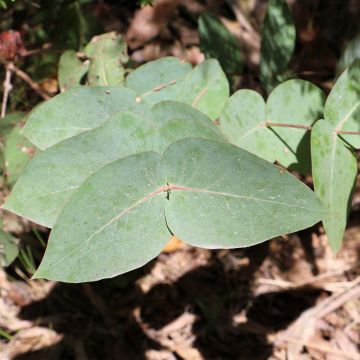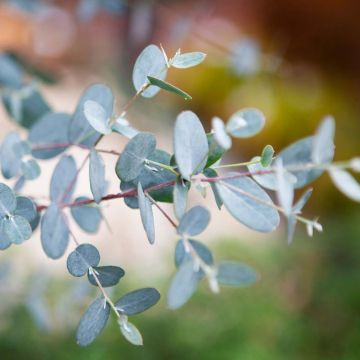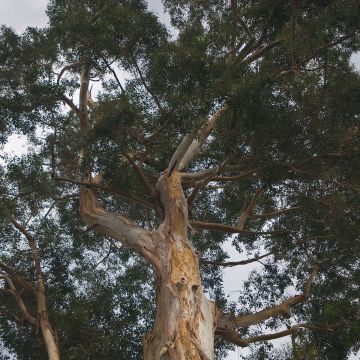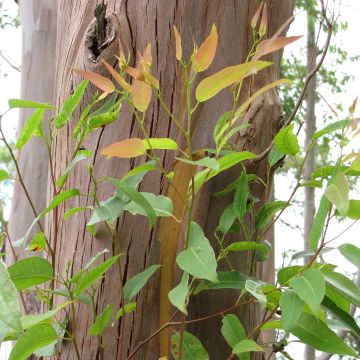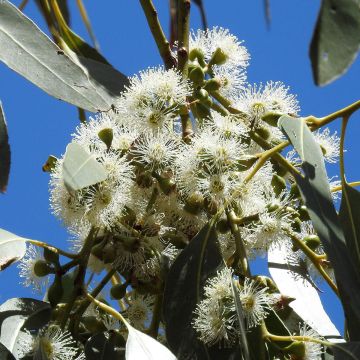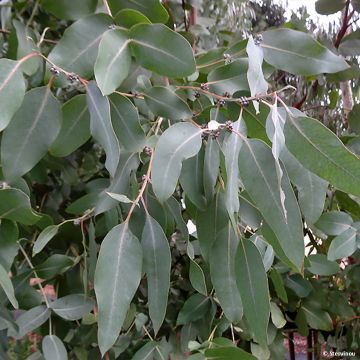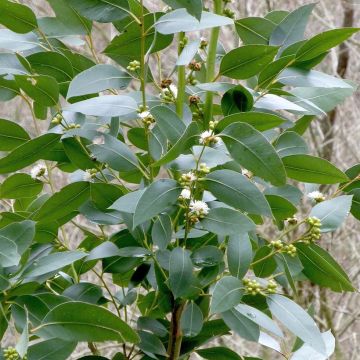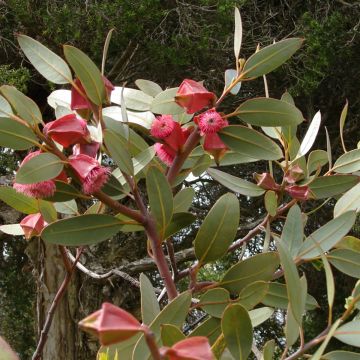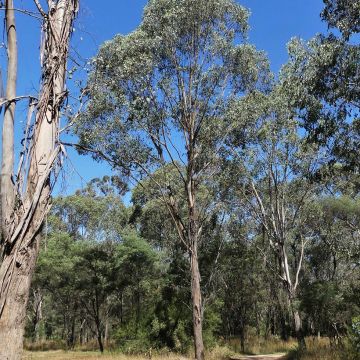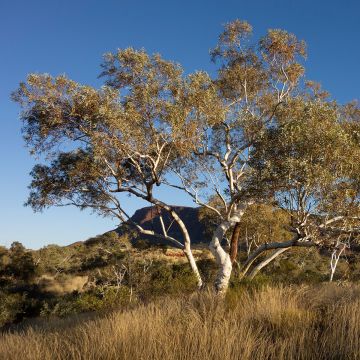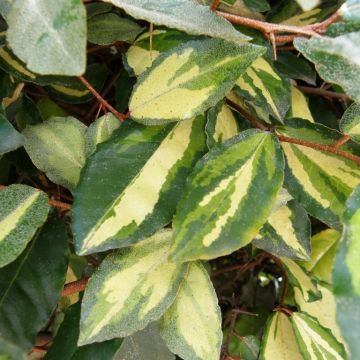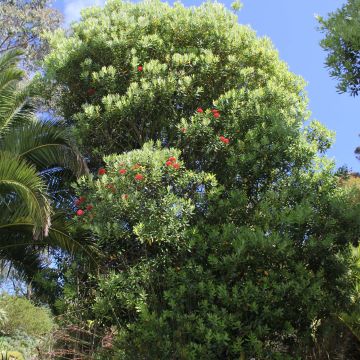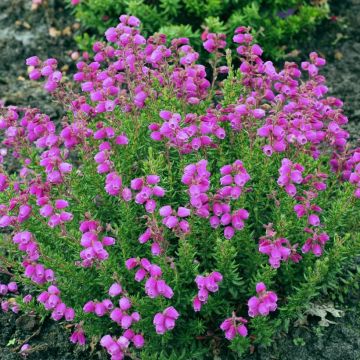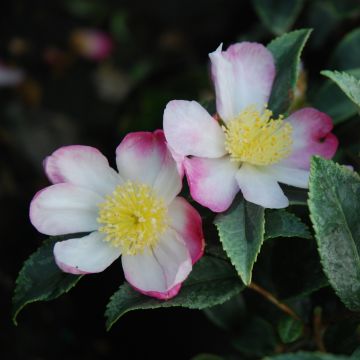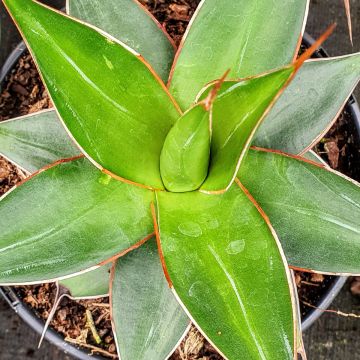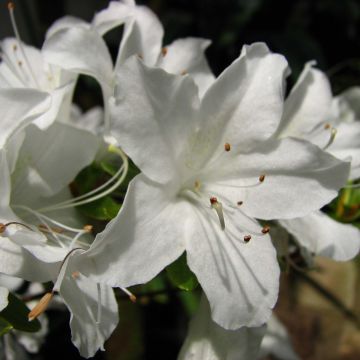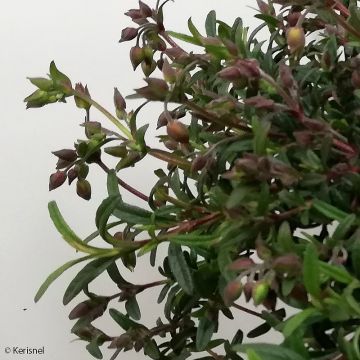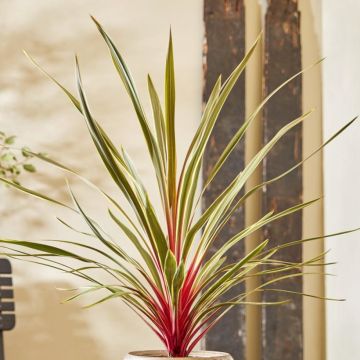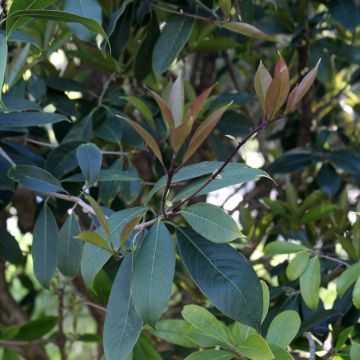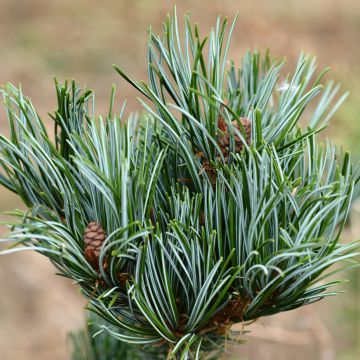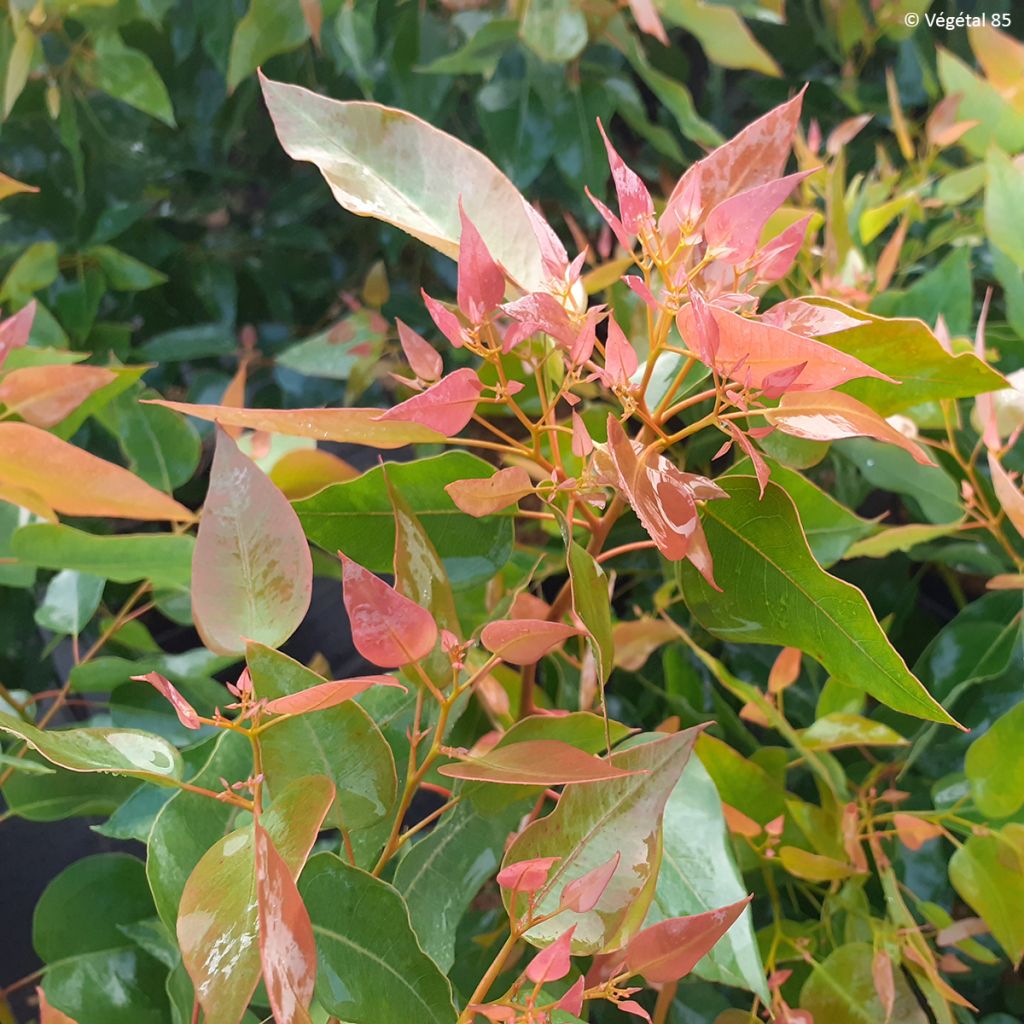

Eucalyptus gomphocephala Kaduri-KKL
Eucalyptus gomphocephala Kaduri-KKL
Eucalyptus (x) gomphocephala Kaduri-KKL
Tuart
Why not try an alternative variety in stock?
View all →This plant carries a 24 months recovery warranty
More information
We guarantee the quality of our plants for a full growing cycle, and will replace at our expense any plant that fails to recover under normal climatic and planting conditions.
From €5.90 for pickup delivery and €6.90 for home delivery
Express home delivery from €8.90.
Does this plant fit my garden?
Set up your Plantfit profile →
Description
Eucalyptus gomphocephala 'Kaduri' is a compact bush that naturally forms a fairly regular ball shape. Its very dense vegetation is made up of thin stems, carrying numerous almost triangular leaves. Its architectural silhouette and the green-blue of its vegetation make it a beautiful subject for planting in isolation. It is not very hardy, its spherical shape resembling some topiaries also makes it suitable for container cultivation, where it will enhance a terrace during the summer and be brought indoors in winter. This Eucalyptus adapts well to a Mediterranean climate with mild winters. It tolerates most types of soil, even poor ones, as long as it is well-drained and enjoys full sun.
Eucalyptus is a member of the Myrtaceae family, which includes about 3000 species of trees and shrubs from temperate to tropical zones. The family is represented by the Common Myrtle in the Mediterranean, and in gardens, mainly by the genera Callistemon (the famous "bottlebrush" with its brush-like flowers) and Acca (the Feijoa). Eucalyptus is a group of plants, rich in more than 800 species, ranging from shrubs a few metres high to immense trees, sometimes reaching over 90 m in height (E. regnans, E. nitens...). Eucalyptus gomphocephala is native to a fairly restricted geographical area in southwestern Australia (Perth region). It grows in a mild to subtropical Mediterranean climate, characterised by dry summers and very mild winters where frost is exceptional, with an annual rainfall of around 550 mm to 700 mm. In these regions, it forms a tall tree with an upright habit, reaching up to 30 m in height and 15 m in width, with a massive trunk that was once used as timber. Its lance-shaped leaves are a shiny glaucous green and its white flowering produces a lot of nectar appreciated by bees.
Eucalyptus x gomphocephala 'Kaduri KKL' was spotted in the Shuvalim forest in Israel and propagated by cuttings by the Gilat nursery, as the plant does not produce seeds. Attached to the KKL-JNF structure, the Gilat nursery's main mission is to produce trees for reforestation in the southern part of the country. This Eucalyptus is a natural hybrid whose second parent has not been identified and which attracted attention because of its dwarf habit. This compact form measures from 1.50 m to 2 m in height with an equivalent width. It is a very dense bush with particularly thin branches that grow in all directions, forming an almost perfect half-sphere. The reddish young shoots are adorned with small leaves twice as long as they are wide, with a triangular shape and a rounded base, carried by petioles of about 2 cm. These juvenile leaves gradually grow and widen, while their colour turns into a beautiful and decorative blue-green. They take on an equilateral triangle shape, with the largest ones reaching approximately 10 cm in length and 6 cm in width.
Eucalyptus gomphocephala 'Kaduri' is attractive for its ornamental foliage all year round and its beautiful blue colour, as well as for its regular ball-shaped habit. It will fit well in a contemporary garden, either in isolation or to form a low hedge. You can also integrate it into a bed with other plants from mild climates. Cassia floribunda, a small shrub with an exotic appearance, with its compound green foliage and its endless summer flowering of yellow pea flowers, will be a perfect companion. Acca sellowiana 'Mammoth', or Brazilian Guava, better known as Feijoa, will delight you with its white flowers from which a bunch of red stamens emerge. To complete your scene, add an Erythrina x bidwillii, a superb fast-growing shrub whose leaves bear some resemblance to those of your dwarf Eucalyptus, and which fascinates throughout the summer with its long clusters of flamboyant coral-red flowers.
Report an error about the product description
Eucalyptus gomphocephala Kaduri-KKL in pictures
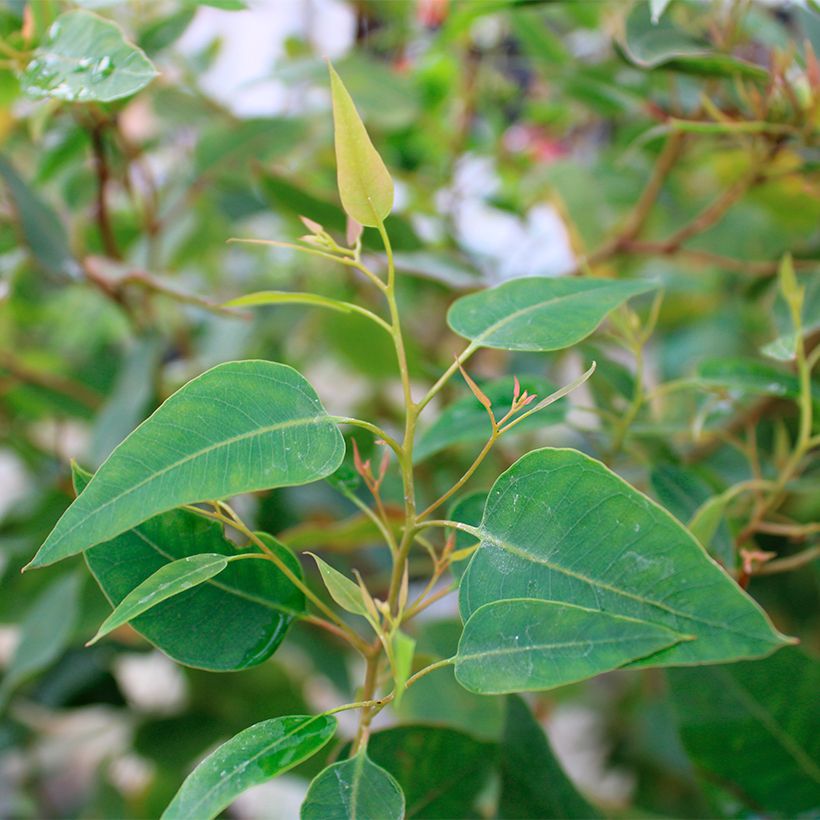

Plant habit
Foliage
Botanical data
Eucalyptus
(x) gomphocephala
Kaduri-KKL
Myrtaceae
Tuart
Australia
Other Eucalyptus
Planting and care
Eucalyptus gomphocephala 'Kaduri' is best planted in early spring in mild and humid regions and in early autumn in dry and hot climates. Plant it in well-prepared, light and well-drained soil, in a very sunny location. Sandy, loamy, slightly clayey, and even limestone soils are well tolerated. A well-established specimen can withstand summer drought relatively well and will only be hardy down to -5 °C. This species from the extreme southwest of Australia thrives better in climates with dry summers and very mild winters. Due to its compact habit, it can be grown in a container and brought indoors for winter protection.
During the first two years, regular watering is necessary, and then only occasionally in summer. Fertiliser is not recommended. Due to its naturally ball-shaped habit, pruning is not necessary, but it is well tolerated in late winter if the stems have been damaged by frost.
Planting period
Intended location
Care
This item has not been reviewed yet - be the first to leave a review about it.
Evergreen shrubs
Haven't found what you were looking for?
Hardiness is the lowest winter temperature a plant can endure without suffering serious damage or even dying. However, hardiness is affected by location (a sheltered area, such as a patio), protection (winter cover) and soil type (hardiness is improved by well-drained soil).

Photo Sharing Terms & Conditions
In order to encourage gardeners to interact and share their experiences, Promesse de fleurs offers various media enabling content to be uploaded onto its Site - in particular via the ‘Photo sharing’ module.
The User agrees to refrain from:
- Posting any content that is illegal, prejudicial, insulting, racist, inciteful to hatred, revisionist, contrary to public decency, that infringes on privacy or on the privacy rights of third parties, in particular the publicity rights of persons and goods, intellectual property rights, or the right to privacy.
- Submitting content on behalf of a third party;
- Impersonate the identity of a third party and/or publish any personal information about a third party;
In general, the User undertakes to refrain from any unethical behaviour.
All Content (in particular text, comments, files, images, photos, videos, creative works, etc.), which may be subject to property or intellectual property rights, image or other private rights, shall remain the property of the User, subject to the limited rights granted by the terms of the licence granted by Promesse de fleurs as stated below. Users are at liberty to publish or not to publish such Content on the Site, notably via the ‘Photo Sharing’ facility, and accept that this Content shall be made public and freely accessible, notably on the Internet.
Users further acknowledge, undertake to have ,and guarantee that they hold all necessary rights and permissions to publish such material on the Site, in particular with regard to the legislation in force pertaining to any privacy, property, intellectual property, image, or contractual rights, or rights of any other nature. By publishing such Content on the Site, Users acknowledge accepting full liability as publishers of the Content within the meaning of the law, and grant Promesse de fleurs, free of charge, an inclusive, worldwide licence for the said Content for the entire duration of its publication, including all reproduction, representation, up/downloading, displaying, performing, transmission, and storage rights.
Users also grant permission for their name to be linked to the Content and accept that this link may not always be made available.
By engaging in posting material, Users consent to their Content becoming automatically accessible on the Internet, in particular on other sites and/or blogs and/or web pages of the Promesse de fleurs site, including in particular social pages and the Promesse de fleurs catalogue.
Users may secure the removal of entrusted content free of charge by issuing a simple request via our contact form.
The flowering period indicated on our website applies to countries and regions located in USDA zone 8 (France, the United Kingdom, Ireland, the Netherlands, etc.)
It will vary according to where you live:
- In zones 9 to 10 (Italy, Spain, Greece, etc.), flowering will occur about 2 to 4 weeks earlier.
- In zones 6 to 7 (Germany, Poland, Slovenia, and lower mountainous regions), flowering will be delayed by 2 to 3 weeks.
- In zone 5 (Central Europe, Scandinavia), blooming will be delayed by 3 to 5 weeks.
In temperate climates, pruning of spring-flowering shrubs (forsythia, spireas, etc.) should be done just after flowering.
Pruning of summer-flowering shrubs (Indian Lilac, Perovskia, etc.) can be done in winter or spring.
In cold regions as well as with frost-sensitive plants, avoid pruning too early when severe frosts may still occur.
The planting period indicated on our website applies to countries and regions located in USDA zone 8 (France, United Kingdom, Ireland, Netherlands).
It will vary according to where you live:
- In Mediterranean zones (Marseille, Madrid, Milan, etc.), autumn and winter are the best planting periods.
- In continental zones (Strasbourg, Munich, Vienna, etc.), delay planting by 2 to 3 weeks in spring and bring it forward by 2 to 4 weeks in autumn.
- In mountainous regions (the Alps, Pyrenees, Carpathians, etc.), it is best to plant in late spring (May-June) or late summer (August-September).
The harvesting period indicated on our website applies to countries and regions in USDA zone 8 (France, England, Ireland, the Netherlands).
In colder areas (Scandinavia, Poland, Austria...) fruit and vegetable harvests are likely to be delayed by 3-4 weeks.
In warmer areas (Italy, Spain, Greece, etc.), harvesting will probably take place earlier, depending on weather conditions.
The sowing periods indicated on our website apply to countries and regions within USDA Zone 8 (France, UK, Ireland, Netherlands).
In colder areas (Scandinavia, Poland, Austria...), delay any outdoor sowing by 3-4 weeks, or sow under glass.
In warmer climes (Italy, Spain, Greece, etc.), bring outdoor sowing forward by a few weeks.

































